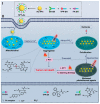Noble Metal Nanoparticle-Based Photothermal Therapy: Development and Application in Effective Cancer Therapy
- PMID: 38891819
- PMCID: PMC11172079
- DOI: 10.3390/ijms25115632
Noble Metal Nanoparticle-Based Photothermal Therapy: Development and Application in Effective Cancer Therapy
Abstract
Photothermal therapy (PTT) is a promising cancer therapy modality with significant advantages such as precise targeting, convenient drug delivery, better efficacy, and minimal adverse effects. Photothermal therapy effectively absorbs the photothermal transducers in the near-infrared region (NIR), which induces the photothermal effect to work. Although PTT has a better role in tumor therapy, it also suffers from low photothermal conversion efficiency, biosafety, and incomplete tumor elimination. Therefore, the use of nanomaterials themselves as photosensitizers, the targeted modification of nanomaterials to improve targeting efficiency, or the combined use of nanomaterials with other therapies can improve the therapeutic effects and reduce side effects. Notably, noble metal nanomaterials have attracted much attention in PTT because they have strong surface plasmon resonance and an effective absorbance light at specific near-infrared wavelengths. Therefore, they can be used as excellent photosensitizers to mediate photothermal conversion and improve its efficiency. This paper provides a comprehensive review of the key role played by noble metal nanomaterials in tumor photothermal therapy. It also describes the major challenges encountered during the implementation of photothermal therapy.
Keywords: combination therapy; noble metal nanomaterials; photothermal therapy; tumor therapy.
Conflict of interest statement
The authors declare no conflicts of interest.
Figures







Similar articles
-
Noble Metal Nanomaterials for NIR-Triggered Photothermal Therapy in Cancer.Adv Healthc Mater. 2021 Mar;10(6):e2001806. doi: 10.1002/adhm.202001806. Epub 2021 Jan 20. Adv Healthc Mater. 2021. PMID: 33470542 Review.
-
Nanomaterials-based advanced systems for photothermal / photodynamic therapy of oral cancer.Eur J Med Chem. 2024 Jun 5;272:116508. doi: 10.1016/j.ejmech.2024.116508. Epub 2024 May 15. Eur J Med Chem. 2024. PMID: 38761583 Review.
-
Design and Functionalization of the NIR-Responsive Photothermal Semiconductor Nanomaterials for Cancer Theranostics.Acc Chem Res. 2017 Oct 17;50(10):2529-2538. doi: 10.1021/acs.accounts.7b00294. Epub 2017 Oct 3. Acc Chem Res. 2017. PMID: 28972736
-
Rationally designed dual-plasmonic gold nanorod@cuprous selenide hybrid heterostructures by regioselective overgrowth for in vivo photothermal tumor ablation in the second near-infrared biowindow.Theranostics. 2020 Sep 19;10(25):11656-11672. doi: 10.7150/thno.51287. eCollection 2020. Theranostics. 2020. PMID: 33052239 Free PMC article.
-
Near-infrared inorganic nanomaterial-based nanosystems for photothermal therapy.Nanoscale. 2021 May 20;13(19):8751-8772. doi: 10.1039/d1nr00323b. Nanoscale. 2021. PMID: 33973616 Review.
Cited by
-
Silver-Titania Nanocomposites for Photothermal Applications.Gels. 2025 Jun 16;11(6):461. doi: 10.3390/gels11060461. Gels. 2025. PMID: 40558760 Free PMC article.
-
Advances in Photothermal Therapy for Oral Cancer.Int J Mol Sci. 2025 May 2;26(9):4344. doi: 10.3390/ijms26094344. Int J Mol Sci. 2025. PMID: 40362580 Free PMC article. Review.
-
Nanotechnology-Based Strategies for Safe and Effective Immunotherapy.Molecules. 2024 Dec 11;29(24):5855. doi: 10.3390/molecules29245855. Molecules. 2024. PMID: 39769944 Free PMC article. Review.
-
Tumor Microenvironment-Responsive Nanoparticles: Promising Cancer PTT Carriers.Int J Nanomedicine. 2025 Jun 23;20:7987-8001. doi: 10.2147/IJN.S526497. eCollection 2025. Int J Nanomedicine. 2025. PMID: 40584786 Free PMC article. Review.
-
Graphene Quantum Dots for Glioblastoma Treatment and Detection-Systematic Review.Molecules. 2025 Jun 6;30(12):2483. doi: 10.3390/molecules30122483. Molecules. 2025. PMID: 40572449 Free PMC article. Review.
References
-
- Agatha C.M., Wijovi F., Putri H., Kurniawan A. Risk of Sarcopenia as the Side Effect of Chemotherapy among Breast Cancer Patients: Preliminary Study. Ann. Oncol. 2018;29:vii82. doi: 10.1093/annonc/mdy375.074. - DOI
Publication types
MeSH terms
Substances
Grants and funding
LinkOut - more resources
Full Text Sources
Medical
Miscellaneous

